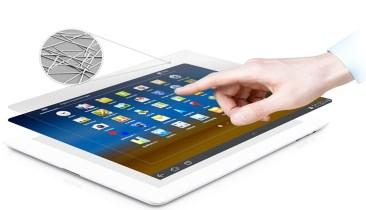



Feature Story
More feature stories by year:
2024
2023
2022
2021
2020
2019
2018
2017
2016
2015
2014
2013
2012
2011
2010
2009
2008
2007
2006
2005
2004
2003
2002
2001
2000
1999
1998
 Return to: 2015 Feature Stories
Return to: 2015 Feature Stories
CLIENT: CAMBRIOS
Oct. 5, 2015: EE Times
Sri Peruvemba, Cambrios Technologies Corp
Beyond consumer electronics, new display technologies will address things like the automotive sector, large area signage, architectural windows, and indoor video walls.
Display technology is rocketing along with other electronic designs. It's being pushed by huge demands for next-generation communication and wearable consumer electronics devices. Together with flexible circuit boards and incredibly miniaturized ICs, a key part of this hot sector's tech mix is the arrival of bendable, moldable, flexible touchscreens enabled by flexible silver nanowires (AgNW).

Adopting this material for advanced touchscreen display technology unleashes nearly unlimited ergonomic consumer product design innovations to catch customers' eyes with fresh style. Beyond that, it also helps meet the needs for notably improved user experiences currently impossible with flat, hard touch interfaces using glass. There is a fast growing range of applications for flexible touchscreens that traditional materials -- specifically indium tin oxide (ITO) on glass -- simply cannot address.
Where flexible touchscreens are making their most recent advances are in smartphones, tablets, and -- as previously mentioned -- in wearable devices, where flexible touch interfaces are a must-have. There are also All-In-One PCs, desktop monitors, and laptops with thin, flexible touchscreens that help reduce weight and thickness while providing 10-finger touch performance with no visual artifacts as are often seen with competing technologies like metal mesh.
The recently introduced Samsung Galaxy Edge Plus smartphone, with its curved touchscreen, is just the latest of many CE devices to come, bringing valuable differentiation to new products.
One of the most exciting areas is that of wearable products offering unique ergonomic forms, low weight, and potential power savings. Product designers haven't begun to scratch the surface of what we'll be seeing and wearing in another 18 to 24 months. Medical and infotainment devices require best-in-class transparency, conductivity, and flexibility, and all of these will quickly gravitate to flexible film-based touchscreen applications.
Sensor-laden helmets, jackets, and badges are also likely end-products. Some other not-too-distant displays may include low-density displays for applications such as a marathon bib, racehorse, or competition cyclist numbers. Even simple novelties like balloons can sport low density displays.
Reaching a bit further in the health sector beyond display apps, electro-stimulation, medical monitors are coming. UV skin docimeters and even electronics in contact lenses hold promise because of silver nanowire's incredible flexibility and transparency versus other materials.
Major electronics OEMs like Samsung, Lenovo, Karbonn, NEC, Toshiba, and LG have shipped products ranging from mobile phones to large-area monitors using silver nanowires. Many others are in development or in the pipeline but not yet public. The switch is on by companies in both the consumer and industrial sectors, driven by product improvements and manufacturing cost benefits.
Technologies that are synergistic with silver nanowires are providing opportunities to explore new applications. Flexible displays have great potential and are enabling many cutting-edge devices. Coming wearables include items similar to Google Glass, wrist-watches, sensor straps, fitness monitors are all waiting to be re-invented with improved style, resolution, and durability, as well as reduced power consumption and weight. Consider how bike helmets, jackets, and even the bikes themselves using flexible displays could be transformed to offer never-before-seen unique features and benefits.
Beyond consumer electronics, new display technologies will address things like the automotive sector, large area signage, architectural windows, and indoor video walls.
Looking at silver nanowire technology from the opposite direction, it can also be applied in myriad ways to generate light and power as well as consuming it, but that's a whole different story for another day.
Sri Peruvemba is vice president at Cambrios Technologies Corp. Headquartered in Silicon Valley, Cambrios provides innovative solutions using nanotechnology. Its silver nanowire-based transparent conductors simplify electronics manufacturing and improve end-product cost and performance for electronic devices.
Return to: 2015 Feature Stories